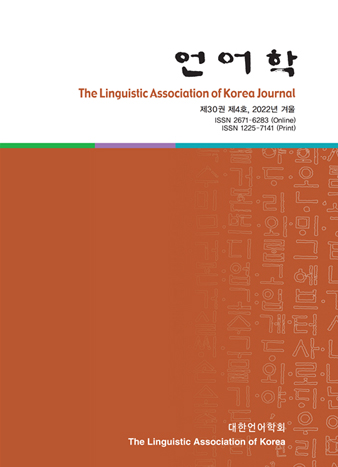대한언어학회 전자저널

30권 4호 (2022년 12월)
- 한국어 부사 부정극어 ‘통’과 ‘영’에 대한 연구: 한국어 교육의 관점에서
-
김설연
Pages : 41-62
Abstract
Jin, Xueyan. (2022). Research on Korean negative polarity items 'tong' and 'yeong': From the perspective of Korean language education. The Linguistic Association of Korea Journal, 30(4), 41-62. This paper aims to research Negative Polarity Items 'tong' and 'yeong' from the perspective of Korean language education. The analysis is done from three aspects: previous research, dictionary, and corpus. First of all, previous research revealed that different researchers have different opinions on the Syntagmatic Relation between 'tong' and 'yeong'. Besides, some problems occurred when vocabulary learning orders were set for Korean learners and no applicable scheme was put forward for Korean language education. Second, the analysis of dictionaries shows that 'tong' and 'yeong' are synonyms, which explains why Korean learners may find it difficult to distinguish them. Moreover the four dictionaries analyzed in this paper did not provide detailed word meanings, syntagmatic relation, and samples. Finally, actual usages of Korean native speakers are analyzed in an objective way and samples from a corpus are also explored. Generally speaking, 'yeong' is used more frequently, which indicates that native Korean speakers use 'yeong' more widely. Specifically speaking, 'tong' is often used in negative sentences while 'yeong' does not show much difference in its usage frequency in negative and positive sentences. This paper also shows that 'tong' and 'yeong' show a tendency of respective combination in sentences, which is explained in detail.
Keywords
# 한국어 교육(Korean education) # 부정극어(negative polarity item) # 유의어(synonym) # 부사(adverb)
References
- 고려대학교 민족문화연구원. (2009). (고려대)한국어사전. 서울: 고려대학교 민족문화연구원.
- 구종남. (2003). 국어 부정극어의 유형. 국어문학, 38, 5-27.
- 구종남. (2011). 국어의 부정극어 허가자와 허가 양상. 韓民族語文學, 59, 549-584.
- 국립국어원. 표준국어대사전. https://stdict.korean.go.kr/main/main.do
- 두산 동아 사서편집국. (2007). (동아)새국어사전. 서울: 두산동아.
- 배미연. (2018). 긍정문에서 나타나는 부정극어 실현 양상 연구. 泮橋語文硏究, 49, 195-224.
- 연세대학교 언어정보연구원. 연세한국어사전. https://ilis.yonsei.ac.kr/ysdic
- 유옥순. (2004). 국어 부정극어의 유형과 의미 특성에 대하여. 순천대학교 석사학위논문.
- 이기종. (1989). 국어 부정구문에 관한 연구- 부정극어를 중심으로. 한남어문학, 15, 163-197.
- 이수현. (2003). 국어 부정 극어에 대한 고찰. 전남대학교 석사학위논문.
- 이원아. (2012) 부정성 부사에 대한 한국어 교육학적 연구. 한국외국어대학교 석사학위 논문.
- 임유종. (2005). 부정소 호응 부사에 의한 연어와 사전 기술. 한국언어문화, 27(0), 235-256.
- 임유종. (2007). 부정 표현과 호응하는 부사의 사용 양상과 한국어 교육. 한민족문화연구, 20(20), 187-214.
- 쩡리엔치. (2014). 중국인 학습자를 위한 한국어 부정극어 부사 연구. 동국대학교 석사학위논문.